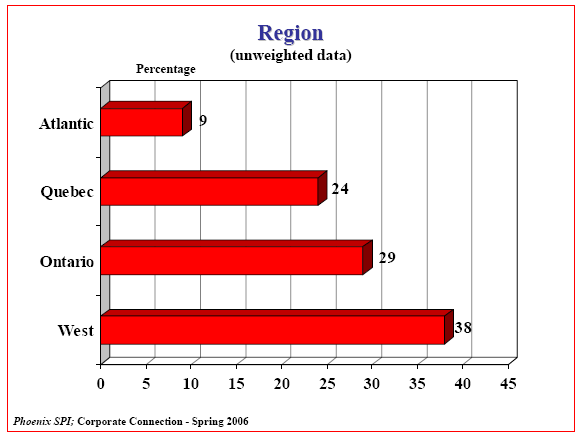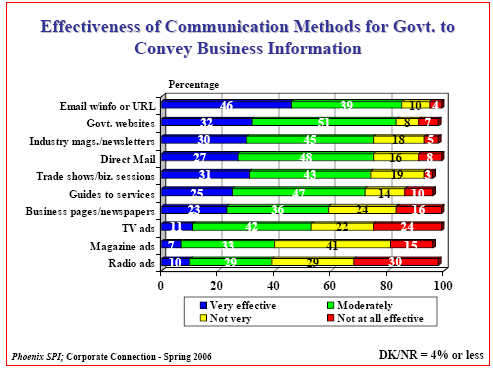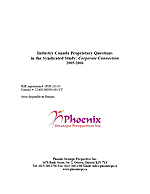Branch and Directorate
The Communication and Marketing Branch's (CMB) Research and Advertising team coordinates all public opinion research (POR) conducted by Industry Canada and is also responsible for the following:
- conducting proprietary research in core areas of interest;
- providing advice on and/or managing POR for other areas of the department; and
- ensuring that all POR research conducted at Industry Canada meets or exceeds industry standards and is conducted in accordance with applicable Government of Canada policies.
Background and Rationale
Ongoing research for and evaluation of programs and services is a requirement of the Communications Policy of the Government of Canada.
On behalf of Industry Canada, the Communications and Marketing Branch subscribes to Corporate Connection, a syndicated survey, undertaken twice yearly among CEOs and senior executives of small, medium and large Canadian firms.
This business survey is of special interest to Industry Canada as it encompasses businesses of all sizes and thus represents the entire business community, one of our key stakeholder groups.
The focus of the study is on topical, broad-based corporate issues, including policy and economic matters, with emphasis on business interaction with government.
Industry Canada's annual subscription agreement entitles the Department to proprietary questions in each wave of the survey.
In 2005–2006, Industry Canada's proprietary questions focused on information and communications issues, especially as they relate to business executives' information relationship with the federal government.
Corporate Connection is a syndicated study that is proprietary to the research firm. With the exception of Industry Canada's own proprietary questions and findings, the Department cannot publicly share the overall report without the express consent of the firm.
Anticipated Outcomes/Benefits
The research findings will help Industry Canada better understand and track the views and preferences of the business community in Canada. The findings will feed into departmental briefings, communications plans and environmental analyses used in the development and tracking of departmental policies and programs relevant to business audiences.
The results will also help the Department to better address business information needs and will help us determine their preferred communications channels for providing relevant information on Government of Canada programs and services that are aimed at business audiences.
Research Information
The survey consists of 30-minute telephone interviews, conducted twice a year, in the spring and in the fall.
In total, 400 interviews are conducted with a mix of small, medium and large firms. The sample is proportionate to the distribution of the business population in Canada by sector and region, as reflected in Statistics Canada's Business Register. A sample of this size is accurate to within +/- 5 percent, 19 times out of 20.
Respondents are Canadian CEOs, presidents, vice-presidents, business owners and other senior decision makers.
Research Firm: Phoenix Strategic Perspectives Inc.
Contract Number: U1400-071624
Contract issued by: PWGSC under the standing offer for quantitative research
Contract value: $26 500.
Industry Canada Proprietary Questions in the Syndicated Study: Corporate Connection 2005-2006
Industry Canada Proprietary Questions in the Syndicated Study: Corporate Connection 2005-2006
POR registration # : POR-210-05
Contract #: U1400-069991/001/CY
Aussi disponible en français
Phoenix Strategic Perspectives Inc.
1678 Bank Street, Suite 2, Ottawa, Ontario K1V 7Y6
Telephone: 613-260-1700
Fax: 613-260-1300
Email: info@phoenixspi.ca
www.phoenixspi.ca
Table of Contents
Introduction
The Communication and Marketing Branch's (CMB) Research and Advertising team coordinates all public opinion research (POR) conducted by Industry Canada and is also responsible for
- conducting proprietary research in core areas of interest
- providing advice on and/or managing POR for other areas of the Department
- ensuring that all POR research conducted at Industry Canada is conducted in accordance with applicable Government of Canada policies
Ongoing research for and evaluation of programs and services is a requirement of the Communications Policy of the Government of Canada.
On behalf of Industry Canada, CMB subscribes to Corporate Connection, a syndicated survey, undertaken twice yearly among CEOs and senior executives of small, medium and large Canadian firms.
This business survey is of special interest to Industry Canada as it encompasses businesses of all sizes and thus represents the entire business community, one of our key stakeholder groups.
The focus of the study is on topical, broad-based corporate issues, including policy and economic matters, with emphasis on business interaction with government.
Industry Canada's annual subscription agreement entitles the Department to proprietary questions in each wave of the survey.
In 2005–2006, Industry Canada's proprietary questions focused on information and communications issues, especially as they relate to business executives' information relationship with the federal government.
Corporate Connection is a syndicated study that is proprietary to the research firm. With the exception of Industry Canada's own proprietary questions and findings, the Department cannot publicly share the overall report without the express consent of the firm.
Industry Canada's questions appeared in the spring 2006 wave of Corporate Connection. For this wave of the study, 403 interviews were completed between May 15 and June 22, 2006. More than half of the sample (54%) consisted of CEOs, presidents and business owners. The results were weighted by size, sector and region to reflect the actual distribution of firms across Canada (according to Statistics Canada's Business Register). Based on a sample of this size, the findings can be considered to be accurate to within +/- 5%, 19 times out of 20.
In advance of the interviews, potential respondents were emailed or faxed an invitation letter. Phone calls were then made to schedule the interviews. Interviews were conducted in French and English and lasted 22 minutes in length. Survey participants will receive a summary of the research findings in appreciation of their participation in the survey.
For this research, quotas were applied based on size of business. Small businesses were those with less than 50 employees, medium-sized were 50-99, and large firms were 100 employees and more (with over half the sample of large firms having 200 or more employees). As noted, following the fieldwork the data were weighted to ensure that the results are proportionate to the distribution of the business population in Canada.
This study was conducted by Phoenix Strategic Perspectives Inc., a public opinion research firm that specializes in public affairs and special audience research, in particular business audiences. Industry Canada's proprietary questions are appended to this report.
Characteristics of Survey Participants
The following graphs present the characteristics of survey participants by business size, position of respondent, and region. Note that unweighted data is used to present the characteristics of survey participants.



Information and Communications Issues
Internet Methods — Most Effective Communications Methods
Business executives were asked to rate the effectiveness of a range of means that the federal government could use to inform them about programs and services for their businesses, as either very, moderately, not very, or not effective at all. The information methods that were rated were as follows:
- Guides to services.
- Pamphlets, booklets or letters sent by direct mail.
- Government of Canada websites.
- Business pages in daily newspapers.
- Email with information or website link.
- Trade shows or business sessions or seminars.
- Information in industry-specific magazines or association newsletters.
- Ads in national or city magazines.
- Television commercials.
- Radio commercials.
While most methods were perceived as being at least moderately effective by most executives, Internet methods stood out. A clear majority rated email with information links as effective (85%), with 46% saying they are very effective. Likewise, 83% said that government websites are effective, with 32% viewing these as very effective. Threequarters (72-75%) held that industry magazines, direct mail, trade shows and seminars, and service guides are effective (25-31% said very effective). A smaller majority of executives said that business pages in newspapers (59%) and television ads (53%) are effective. Conversely, a majority found radio (59%) and magazine (56%) ads to be ineffective.

The following graph shows the same information in aggregated, simplified form:

Executives of small firms were more likely to say that three of the top four methods would be effective. These included email (86% vs. 80-84%), government websites (84% vs. 72- 81%), and direct mail (79% vs. 57-63%). Interestingly, as firms became larger, executives were less likely to perceive direct mail to be effective, while executives of large firms were the most likely to view industry publications as effective (81% vs. 68-75%). Executives of medium-sized firms were the least likely to consider each of the top four methods to be effective.
| Small | Medium | Large | |
|---|---|---|---|
| Email with information or URL | 86% | 80% | 84% |
| Government websites | 84% | 72% | 81% |
| Industry magazines or newsletters | 75% | 68% | 81% |
| Direct mail | 79% | 63% | 57% |
| Trade shows and business information sessions | 77% | 59% | 66% |
| Guides to services | 73% | 76% | 66% |
| Business pages in newspapers | 56% | 72% | 74% |
| Television advertisements | 55% | 35% | 47% |
| Magazine advertisements | 40% | 42% | 45% |
| Radio advertisements | 38% | 56% | 32% |
Executives in the Atlantic and Western regions were more likely to view email with information as effective (91% vs. 78-83% elsewhere). Those in the Atlantic region were also much more likely to say that government websites would be effective (96% vs. 77- 85% elsewhere).
| Atlantic | Quebec | Ontario | West | |
|---|---|---|---|---|
| Email with information or URL | 91% | 78% | 83% | 91% |
| Government websites | 96% | 77% | 85% | 81% |
| Industry magazines or newsletters | 66% | 64% | 75% | 84% |
| Direct mail | 82% | 69% | 67% | 86% |
| Trade shows and business information sessions | 57% | 65% | 77% | 81% |
| Guides to services | 68% | 78% | 66% | 77% |
| Business pages in newspapers | 51% | 73% | 61% | 50% |
| Television advertisements | 59% | 44% | 52% | 56% |
| Magazine advertisements | 41% | 47% | 43% | 34% |
| Radio advertisements | 36% | 29% | 39% | 46% |
Appendix
Information and Communications Issues
For each of the following means available to the Government of Canada for informing you about programs and services related to your business, please indicate how effective you find each of the following. How about…? (Read And Rotate) Would you say very effective, moderately, not very or not at all effective? T04 MODIFIED
- Guides to services.
- Pamphlets, booklets or letters sent by direct mail.
- Government of Canada websites.
- Business pages in daily newspapers.
- Email with information or website link.
- Trade shows or business sessions or seminars.
- Information in industry-specific magazines or association newsletters.
- Ads in national or city magazines.
- Television commercials.
- Radio commercials.

